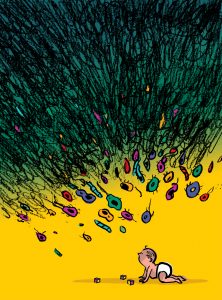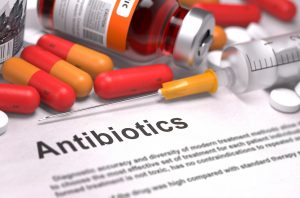The first 100 days of birth is critical window for the colonisation and development of the right bacteria in our gut.
Several studies have indicated that a compromised microbiota at birth and in the first 100 days of life is a risk factor for allergy and obesity.
Intestinal crosstalk with colonising bacteria in the developing intestine is critical to the normal development of host defense.
It affects the infant’s adaptation to extrauterine life (immune homeostasis) and provides protection against disease such as allergy and obesity later in life.

Disrupted colonisation (dysbiosis) due to maternal dysbiosis, cesarean section delivery, use of perinatal antibiotics, or premature delivery may adversely affect the gut development of host defense, leading to increased susceptibility to disease later in life.
Reductions in bifidobacteria and members of the Bacteroidaceae family (e.g. Bacteroides) are by far the most common perturbations in microbial composition following the medical interventions, such as caesarean section and antibiotic use. On the other hand, genus Clostridium and the Enterbacteriaceae (e.g. Klebsiella, Escherichia coli) are likely to become more abundant in infants delivered by caesarean, exposed to maternal antibiotics, and treated with antibiotics.

A Study in Asia
Researchers from National University of Singapore, University of Turku in Finland, Wageningen University in The Netherlands, and Nutricia Research were to determine the effect of mode of delivery and intrapartum antibiotic prophylaxis (IAP) on the maturation of Asian infant gut microbiota. In Asia, Intrapartum antibiotic prophylaxis (IAP) was commonly administered to prevent neonatal group B Streptococcus (GBS) infection or post-caesarean maternal infection.
Three groups of healthy term-born infants were recruited from the National University Hospital Singapore: (1) Infants born vaginally; (2) Infants born vaginally whose mothers received IAP; and (3) Infants born by C-section.
Study Findings
A delayed colonization by Bifidobacterium was observed in infants born vaginally whose mothers received IAP and infants born by C-section, but not in vaginally born infants. This was statistically significant at day 7 and 1 month. In contrast to infants born vaginally (with and without IAP exposure), C-section born infants featured a delayed colonization by Bacteroides from day 7 till 3 months.
The relative abundance of Enterobacteriaceae was higher in infants born vaginally whose mothers received IAP and infants born by C-section, compared to infants born vaginally at day 7 and 1 month.
A negative correlation between Bifidobacterium and Enterobacteriaceae was observed at day 7 and 1 month. At day 7, the species diversity was higher in infants born vaginally compared to infants born vaginally whose mothers received IAP and infants born by C-section.
What does this mean?
“Our study showed that Intrapartum Antibiotic Prophylaxis and C-section impair the early microbial colonisation and this may represent a risk factor for the development of immune or metabolic disorders,”
said Christophe Lay, Honorary Adjunct Assistant Professor from the Department of Paediatrics, National University of Singapore.
The compromised microbiota was translated as a delayed colonization by keystone colonisers, Bifidobacterium and Bacteroides, both strict anaerobes have the ability to metabolise human milk oligosaccharides.
It was also associated with an enrichment of facultative anaerobes/aerobes (Klebsiella).
“We hope to investigate the effect of feeding pattern in the near future.
I believe that nutritional intervention with tailored microbiome modulators (probiotics, prebiotics, synbiotics) could be a strategy to reduce the disease risk associated with a compromised microbiota,”
Dr Lay commented.
The study was presented in the International Scientific Association for Probiotics and Prebiotics (ISAPP), which took place in Singapore, June 5-6, 2018. Themed “Key Scientific Drivers Behind Probiotic and Prebiotic Applications”, it was the very first conference of ISAAP in Asia.
The abstract about this study can be found here.